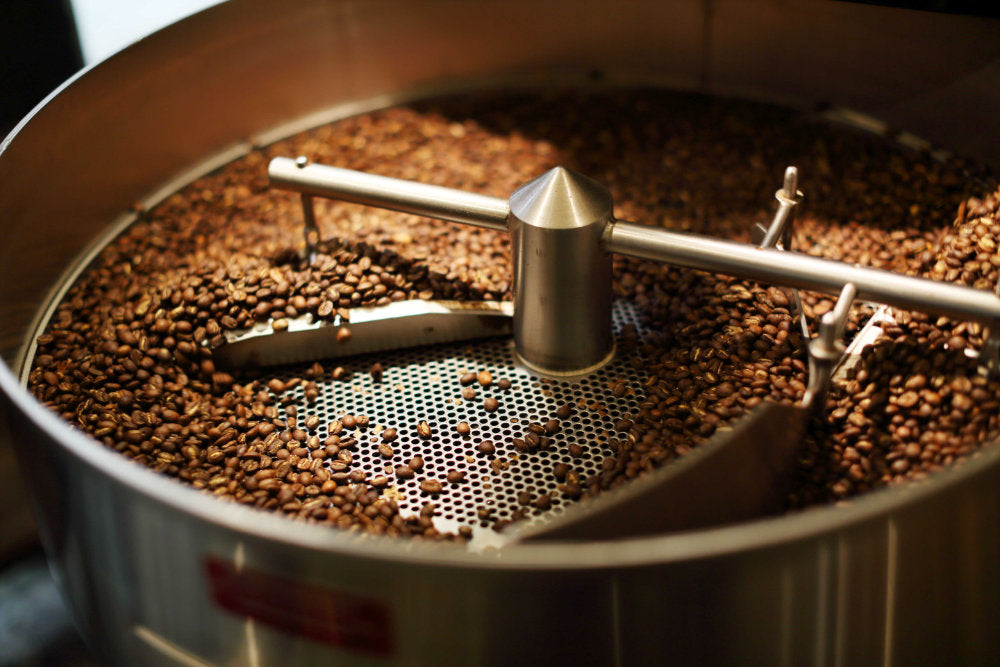Roasted coffee beans oils
Roasted coffee beans are either matte (dry) or shiny (oily). Beans looks shiny due to the presence of oils, the amount of which varies from just a few drops to complete coverage.In this article, we’ll explain the nature of these oils and what determines their quantity.
Oily Coffee Beans: Good or Bad?

Drops of oil on roasted coffee beans are in fact the essential oils that are released during the roasting process. Actually, the smell of coffee is so quintessential and memorable mainly due to its presence on the surface. However, it is not necessarily a good thing.
First of all, oil oxidation (when in contact with oxygen from the air) is one of the main causes of coffee beans becoming stale.
Secondly, essential oils are needed mainly for coffee’s taste, while oils on the surface lose volatile aromatic compounds much quicker. As a result, such coffee smells better but tastes worse.
Typically, the presence of oils on roasted coffee bean's surface does not create the most pleasant taste as a result of temperatures causing sugar’s burning and acids breaking down when oils are released in the roaster. Consequently, the coffee will most often taste extremely bittern and slightly sour.
Coffee blend is considered “Good” when it’s not oily at all or contains a very small amount of oils. Their quantity depends on many reasons, which will be discussed below.
Why Coffee Beans are Oily.

Beans on the right are coated with oils and therefore shine, on the left- beans of medium roast and they have no oils on the surface.
One of the main and simplest reasons is the change in temperature during roasting. There are usually no oils found on light or medium coffee beans, however, dark beans are almost often oily as a result of an active caramelization process during which the bean structure becomes more porous.
Every once in a while, oils are released on espresso coffee beans, since they are roasted for a longer period of time. The quantity varies from rare drops to full coverage.
Coffee Roasting Mistakes:
The essential oils are often released not because of the roasting temperatures, but due to the mistakes made during the process.
Professionals call the release of oils on the beans' surface “The Oil Migration”, which takes place when the level of moisture changes within the outer and inner layers of the bean.
The moisture content is distributed evenly throughout the bean and is equal to 9–12% prior to roasting. The water inside the beans is either free or bound. The free water almost completely evaporates during "drying" - the first stage of roasting, whereas the bound one - when in conjunction with other elements inside the cell walls, evaporates more slowly, almost to the end of the roast.
The temperature of the outer level of beans is higher than in the inner ones during the roasting process, consequently - the rate of evaporation of bound water in the outer layers is higher.
If the mistake is made during roasting, for example - too much conduction is applied with insufficient radiation energy, then the difference in moisture between the layers of the bean will cause the oils to "migrate", e.i transfer into the layers of the bean, where the humidity and cell wall density are lower.
Oil can appear even on light-roasted beans if the coffee is roasted incorrectly.
In particular, the appearance of dark spots on the beans (scorching) may be caused if the drum roaster is not heated up enough, while the coffee is roasted at high burner power values or loaded into a drum that is too hot.
Lengthy Cooling:

The processes inside the beans do not stop after roasting but continue during the cooling phase. The beans are cooled by a massive airflow in a cooling mixer. If the coffee is cooled for too long, the airflow will dry out the surface of the bean while chemical processes are still taking place inside. Moreover, when it prolongs, a large airflow sweeps away some of the flavors, making the coffee less vibrant.
Storing Roasted Coffee.
Oil Migration does not just happen immediately after roasting, but also during storage. The oils are released for several months after roasting. Therefore, one drop of oil on the beans today could increase significantly within a few weeks of storage.
This, by the way, is one of the reasons why not even the darkest coffee from Italian brands is shiny and covered with oil. Most of the time it has already aged.
Coffee Characteristics.
There are some types of coffee with the cellular structure of the beans or high sugar content, which causes the release of oils. In the article about processing methods, we mentioned that naturally processed coffee often contains more sugars and has a more porous cellular structure. Therefore, caramelization processes become more active, and the risks of burning sugars and destruction of cell walls on the surface are higher.
The same is true for coffee blends with low density, that is, coffee that grows at a lower altitude. Oil Migration will take place if it's roasted too fast. An identical effect will be enhanced if you roast old green beans with the moisture level decreased to 7-8 %.
These types include any naturally processed Ethiopian, Brazilian or Peruvian Coffee that grows at low altitudes, together with some non-standard processing methods such as “monsoon” in India or water decaffeination.
Worth Noting
Oily beans are neither good nor bad when it comes to taste. It mostly means that the coffee is roasted dark enough, and therefore will taste extremely bitter and slightly sour.
Occasionally, Whe you buy roasted coffee beans the presence of the oils indicates that coffee has been stored for a very long time and has most likely lost most of its flavor characteristics.
On the other hand, the presence of oils is quite normal for some types of coffee, which can be very delicious when fresh.

